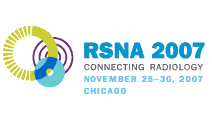
Abstract Archives of the RSNA, 2007
LL-BR2126-H07
Computer-assisted Diagnosis (CAD) Systems for MR-Mammography: Do They Bring Benefit for Radiological Diagnosis or Cause Confusion?
Scientific Posters
Presented on November 27, 2007
Presented as part of LL-BR-H: Breast Imaging
Diane Miriam Renz MD, Presenter: Nothing to Disclose
Pascal Andreas Thomas Baltzer MD, Abstract Co-Author: Nothing to Disclose
Petra Eva Kullnig MD, Abstract Co-Author: Nothing to Disclose
Joachim Boettcher MD, Abstract Co-Author: Nothing to Disclose
Werner Alois Kaiser MD, PhD, Abstract Co-Author: Researcher, Siemens AG
Researcher, Bayer AG (Berlex Inc)
Researcher, General Electric Company (Amersham plc)
Researcher, Suros Surgical Systems, Inc
Researcher, C. R. Bard, Inc
Researcher, Boston Scientific Corporation
Researcher, Galil
Researcher, Invivo
Researcher, Confirma
Researcher, CAD Sciences
Researcher, Carl-Zeiss
The role of CAD-systems as primary diagnostic tool or as second reader is discussed controversially. We performed this study to evaluate the clinical potential of CAD for assisting radiologists during their analysis of breast MR images.
The MR images (1.5T; 0.1 mmol Gd-DTPA/kg bw) were evaluated by three radiologists (observer 1 and 2 specialized in MR-Mammography, observer 3 not specialized in breast imaging). The images were initially analyzed visually and afterwards with two CAD-systems: Full-time-point (FTP) method (Cadsciences, USA) and Dynacad Version 1.1 (Invivo, USA). The observers rated the benignity/ malignity of all lesions using the BI-RADS classification and estimated their confidence (1: low vs. 2: high confidence).
88 lesions (43 malignant, 45 benign) were detected in 48 patients. Before and after CAD, the scoring on BI-RADS correlated highly significantly between the three readers (p<0.01). After the usage of CAD, the observers considered themselves more often to have high confidence (2): observer 1 (pre-CAD 87.0%; 92.0% FTP/ 95.0% Dynacad), observer 2 (84.0%; 88.0%/ 93.0%), observer 3 (62.0%; 84.0%/ 95.0%). After CAD analysis, all three radiologists classified more malignant lesions as BI-RADS score 4 or 5: observer 1 (97.7%; 100.0%/ 100.0%), observer 2 (93.1%; 95.3%/ 95.3%), observer 3 (86.1%; 100.0%/ 90.7%). After CAD, the two experienced radiologists categorized about the same quantity of benign lesions correctly as BI-RADS score 2: observer 1 (84.4%; 84.4%/ 86.7%) and observer 2 (93.3%; 91.1%/ 93.3%). The less experienced observer 3 classified less benign lesions as BI-RADS score 2 after CAD analysis: 77.8%; 66.7%/ 73.3%.
CAD-systems increase the confidence of observers during their analysis of breast lesions, especially in less experienced observers. Computer-assisted diagnosis seems to be particularly useful in evaluating malignant lesions. However, CAD might cause confusion in less experienced observers during their interpretation of benign lesions.
CAD in MR-Mammography can be a helpful tool for radiologists because of increase of confidence. Especially in analyzing malignant lesions, CAD seems to be a promising feature for clinical routine.
Renz, D,
Baltzer, P,
Kullnig, P,
Boettcher, J,
Kaiser, W,
Computer-assisted Diagnosis (CAD) Systems for MR-Mammography: Do They Bring Benefit for Radiological Diagnosis or Cause Confusion?. Radiological Society of North America 2007 Scientific Assembly and Annual Meeting, November 25 - November 30, 2007 ,Chicago IL.
http://archive.rsna.org/2007/5012801.html

